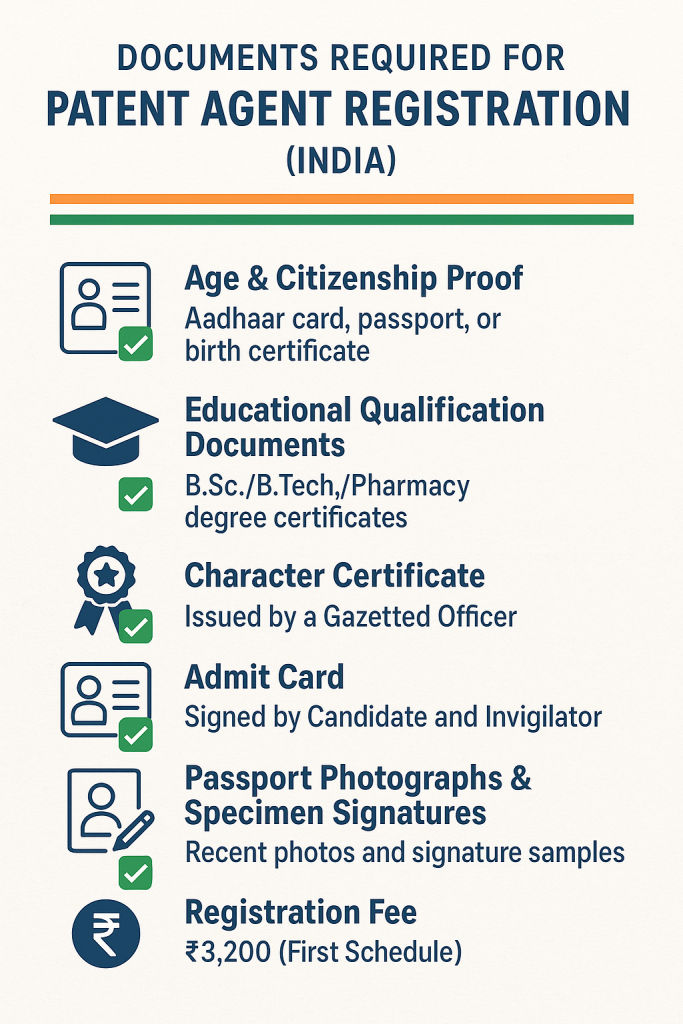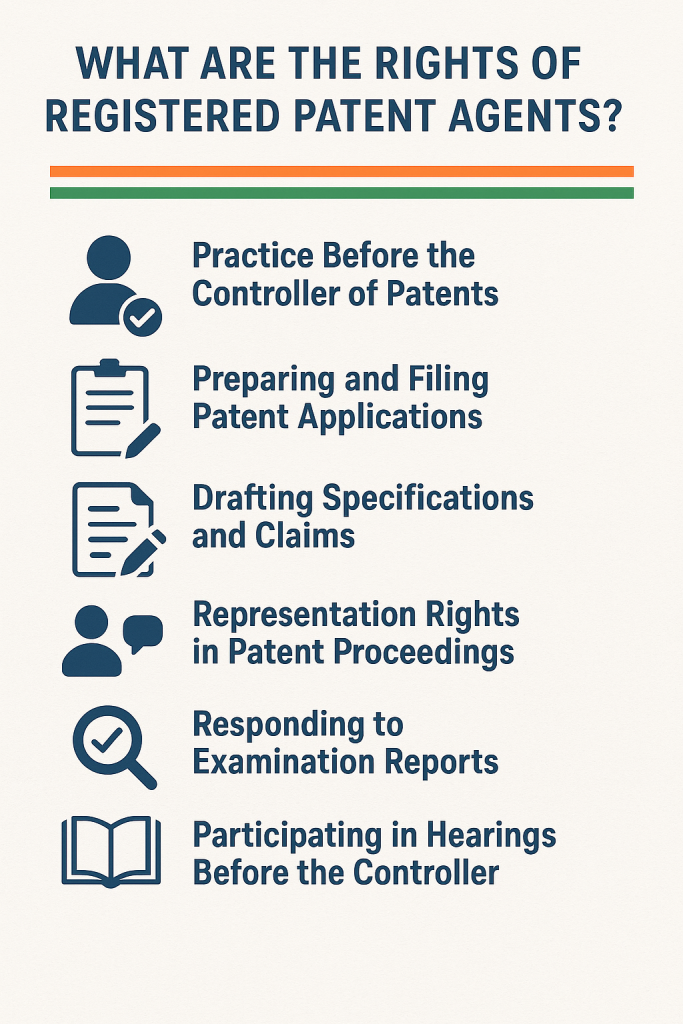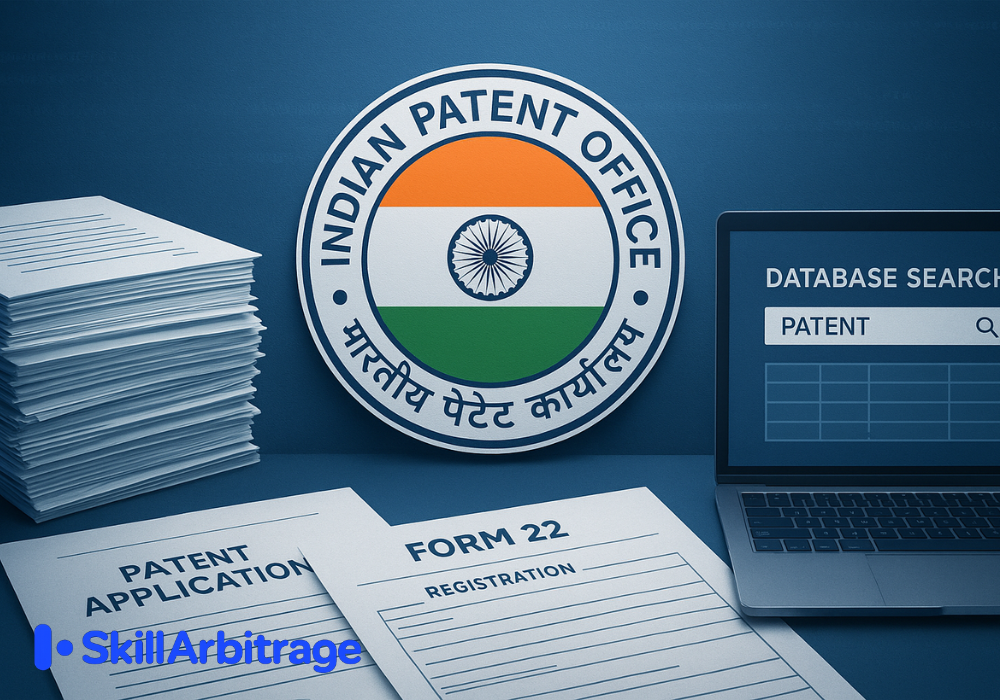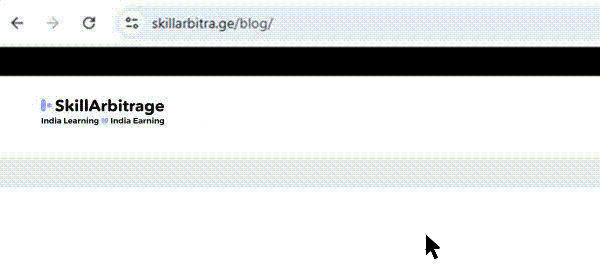What is the Indian Patent Agent Register? Understand the Registration process with Form 22, Electronic Register search, annual maintenance, rights & removal. Official procedures explained for patent aspirants.
Table of Contents
If you’ve just passed the Indian Patent Agent Examination, you might think you’re ready to start practicing before the Patent Office. Here’s what you need to know: passing the exam is only half the journey. The Indian Patent Agent Register exists as the official record of professionals authorized to practice patent law in India, and your name must be entered in this register before you can represent clients.
The register serves as the legal backbone of India’s patent system, ensuring that only qualified professionals handle the complex technical and legal work of patent prosecution. Under Section 125 of the Indian Patents Act, 1970, only registered patent agents and advocates can practice before the Controller of Patents. This means you cannot draft patent applications, file documents, or represent clients in patent proceedings without registration, regardless of your exam score.
The Patent Office maintains this register to protect both inventors and the integrity of the patent system. When you register, your name, qualifications, address, and registration details become part of an official database that anyone can verify. This transparency helps inventors make informed decisions when hiring patent professionals and prevents unqualified individuals from misrepresenting themselves as authorized agents.
Think of the register as your professional license. Just as doctors need to be registered with medical councils or lawyers with bar councils, patent agents must be registered with the Indian Patent Office. The Controller General of Patents, Designs and Trademarks oversees this register, maintaining it under the authority granted by the Patents Act, 1970 and Patent Rules, 2003.
Ensuring Professional Standards for Patent Practice
I want to emphasize something crucial: the register isn’t just a formality—it’s a quality control mechanism. The registration process verifies your educational qualifications, ensures you’ve passed the rigorous Patent Agent Examination, and confirms your good character through required certifications. This multi-step verification protects the patent system from fraudulent practitioners.
The register also establishes accountability. Once registered, you’re subject to professional conduct standards and can be removed from the register for misconduct, fraud, or failure to maintain registration requirements. This accountability ensures that patent agents maintain high professional and ethical standards throughout their careers. Your registration number becomes your professional identity; every document you file with the Patent Office will bear this number.
The register also facilitates the annual continuation process, which I’ll explain in detail later. This yearly renewal requirement ensures that only active, qualified professionals remain authorized to practice. It’s not just about collecting fees; it’s about maintaining an up-to-date database of practicing patent agents who meet current professional standards.
Who Needs to Be Registered in the Indian Patent Agent Register?
Understanding who must register helps clarify your own path forward. The registration requirement applies to specific categories of professionals who meet the qualifications outlined in Section 126 of the Patents Act. Let me walk you through each category so you know exactly where you stand.
Patent Agent Exam Qualifiers
If you’ve successfully passed the Indian Patent Agent Examination, you fall into the primary category requiring registration. The exam tests your knowledge of the Patents Act, Patent Rules, drafting procedures, and prosecution strategies. However, and I cannot stress this enough, passing the exam does not authorize you to practice.
Here’s what the exam qualification means: you’ve demonstrated the knowledge necessary to practice as a patent agent, but you haven’t yet received official authorization from the Controller. Your exam certificate proves your competence, but only your registration certificate grants you the legal right to represent clients before the Patent Office.
The examination consists of two written papers:
- Paper I on Patent Act and Rules,
- Paper II on drafting and prosecution
- Viva voce.
You need a minimum of 50% in each component with a 60% aggregate to pass. Final-year engineering or science students can appear for the exam, but you cannot register until you’ve obtained your actual degree certificate. The Patent Office gives you two months from the exam result announcement to produce your degree if you were a final-year student during the exam.
Mandatory Registration Requirement After Qualification.
Any attempt to practice without registration violates Section 129 of the Patents Act, which prohibits unregistered persons from describing themselves as patent agents or practicing as such.
The registration process involves submitting Form 22, providing documentation, paying fees, and waiting for Controller verification, which I’ll detail in the next section. Plan for this timeline before making professional commitments. Some candidates assume they can practice while their registration is “pending,” but this is incorrect. You must wait for your certificate of registration and entry in the Electronic Register before accepting any patent work.
Special Exemption for Patent Office Examiners
There’s a special category of professionals who can register without taking the Patent Agent Examination. If you’ve worked as a Patent Office examiner or discharged Controller functions under Section 73 for at least 10 years, you qualify for exemption under Section 126 of the Patents Act.
This exemption recognizes that Patent Office examiners gain extensive practical knowledge of patent procedures through their work. If you’ve spent a decade examining applications, drafting office actions, and applying patent law, you’ve essentially demonstrated competence equivalent to passing the exam. However, you must have ceased holding such capacity at the time of applying for registration; current Patent Office employees cannot register as agents.
10-Year Service Exemption Under Section 126(1)(d)
The 10-year service exemption has specific requirements. Your service must total at least 10 years, either as an examiner, or discharging Controller functions, or a combination of both. Part-time or temporary positions typically don’t count; the service must be substantive government service with the Patent Office.
When you apply for registration under this exemption, you’ll need to provide service records, experience certificates, and documentation proving your tenure and responsibilities. The Controller verifies this information thoroughly. You still need to meet other requirements: Indian citizenship, minimum age 21, and technical qualifications (degree in science, engineering, or technology). The exam exemption doesn’t waive documentation or fee requirements; you’ll still submit Form 22 and all supporting documents just like exam qualifiers.
How to Register as a Patent Agent After Passing the Exam
Now we reach the practical core of this guide: actually registering yourself in the Indian Patent Agent Register. This process requires careful attention to documentation, procedures, and timelines. I’ll walk you through every step so you can complete your registration without delays or rejections.
What is Form 22 for Patent Agent Registration?
Form 22 is the official application form for patent agent registration specified under Rule 109 of the Patent Rules, 2003. This form is your formal request to the Controller to enter your name in the Register of Patent Agents. You can access Form 22 through the official IP India website at ipronline.ipindia.gov.in/eAgentfiling/goForLogin/doLogin for online submission.
The form captures essential information: your personal details (name, father’s name, date of birth, nationality), contact information (address, phone, email), educational qualifications (degree details, university, year of passing), and examination details (exam year, registration number, marks obtained). You’ll also provide bank details for future correspondence and your preferred language for communication with the Patent Office.
Form 22 comes with online electronic form submission. The online portal guides you through each field with validation checks that prevent common errors. If you choose offline submission, ensure you print clearly, sign in the designated spaces, and include all annexures.
What Documents Are Required for Registration?
Documentation is where most registration delays occur, so pay close attention to these requirements. The Controller verifies every document, and missing or improperly formatted documents will cause rejections. Let me break down each required document with specific formatting requirements.
Age and Citizenship Proof Requirements
You need to provide self-attested copies of documents proving you’re at least 21 years old and an Indian citizen. Acceptable age proof documents include passport, PAN card, Aadhaar card, birth certificate, school leaving certificate, tenth standard mark sheet, driving license, or any government-issued ID card with date of birth. Make clear photocopies, attest each page with your signature and date, and ensure the date of birth is clearly visible.
Educational Qualification Documents
Submit self-attested copies of your degree certificate in science, engineering, or technology as required under Section 126(1)(c). If you’re a final-year student who appeared for the exam before graduation, you must now provide your actual degree certificate along with all mark sheets. The degree must be from a university established under Indian law; foreign degrees require equivalence certificates from the Central Government or the Association of Indian Universities.
Character Certificate from a Gazetted Officer
This is a critical document that many candidates get wrong. You need an original character certificate, not a photocopy, issued by a gazetted officer. The certificate must be recent (typically within 3 months of application), on the officer’s official letterhead, with their designation, signature, and official seal/stamp clearly visible. The certificate should state that you’re of good character and moral standing. Gazetted officers include government officials, magistrates, or senior public servants; private company executives don’t qualify, regardless of their position.
Admit Card Signed by Candidate and Invigilator
You must submit your original Patent Agent Examination admit card bearing the signatures of both yourself and the invigilator who supervised your exam. This document verifies that you actually appeared for the examination. Many candidates lose their admit cards after the exam. If you’ve done this, immediately contact the Patent Office at [email protected] to request a duplicate or certified copy. Don’t submit photocopies without verification, as these will be rejected.
Passport Photographs and Specimen Signatures
Provide two recent passport-size color photographs (typically 3.5 cm × 4.5 cm) with a white background, showing clear facial features. Write your name on the back of each photograph. Additionally, provide two specimen signatures on plain white paper; these will be kept on record in the Patent Register and used to verify your identity on official documents. Sign naturally as you would on legal documents, ensuring consistency with your signature on Form 22 and other documents.
What is the Registration Fee for Patent Agents?
Fee Structure Under the First Schedule of Patent Rules
The registration fee is specified in the First Schedule of the Patent Rules, 2003. The registration fee is ₹3,200, payable at the time of submitting Form 22. However, fee structures can change with amendments, so always verify the current fee on the IP India website before payment. The fee covers the Controller’s processing of your application, verification of documents, entry in the register, and issuance of your registration certificate.
This initial ₹3,200 registration fee is separate from the annual continuation fee. Think of the registration fee as a one-time charge for entering the register, while continuation fees are recurring annual charges to maintain your registration. You cannot pay continuation fees until after you’re registered, so don’t confuse the two when making your initial payment.
Payment Methods
For online Form 22 submissions, you can pay electronically through the IP India payment gateway using net banking, debit card, or credit card. The system generates a payment receipt immediately upon a successful transaction. Save this receipt, as you’ll need to reference the transaction ID in your Form 22 submission.

Step-by-Step Registration Process
Preparing Your Form 22 Application
Begin by gathering all your documents before starting the Form 22 application. Create a checklist: exam certificate, degree certificate, character certificate (original), age proof, citizenship proof, admit card, photographs, specimen signatures, and fee payment confirmation.
Have digital scans ready if applying online (PDF format, each document under 2 MB). Fill out Form 22 carefully, double-checking every entry—name spelling, date of birth, address, qualification details, against your supporting documents for consistency.
Log in to the portal using the credentials you created during exam registration. Navigate to “Registration as Patent Agent” and select “New Application.” Fill each section systematically, uploading documents as prompted. The system allows you to save drafts, so you don’t need to complete everything in one session. Before final submission, review the preview of your completed application thoroughly.
Submitting Documents to the Controller
Once you’ve completed Form 22 and attached all documents, pay the registration fee through the online gateway. After payment confirmation, submit your application electronically. You’ll receive an acknowledgment number. Save this for tracking your application status.
Along with your Form 22, ensure you include the original character certificate (not a photocopy), original or verified copies of your admit card, and the fee payment receipt. Create a cover letter listing all enclosed documents with your contact information for the Controller to reach you if clarifications are needed.
You must also send all the documents to the Patent Office, Mumbai.
Controller Verification and Processing
After submission, the Controller’s office verifies your documents systematically. They check your exam qualification against Patent Office records, verify your degree against university databases, confirm your character certificate, and ensure all required documents are properly formatted and attested. This verification process typically takes 2-4 weeks for online applications and 4-8 weeks for offline applications, though timelines vary based on application volume and any clarifications needed.
If the Controller finds discrepancies or missing documents, they’ll contact you via email or phone requesting corrections. Respond promptly with the required information or corrected documents to avoid further delays. Common issues include unclear photograph quality, improperly attested documents, or character certificates that don’t meet format requirements.
What Happens After Your Application is Approved?
Certificate of Registration Issuance
Once the Controller approves your application, they issue a Certificate of Registration as a Patent Agent. This official document includes your name, registration number, registration date, and the Controller’s signature and seal. Your registration number is your permanent professional identifier; you’ll use it on every patent document you file for your entire career. The certificate is sent to your registered address by post, or you can download a digital copy from the registration portal if you applied online.
Entry in the Electronic Register of Patent Agents
Simultaneously with certificate issuance, the Controller enters your details in the Electronic Register of Patent Agents. This publicly searchable database includes your name, registration number, registration date, address, and contact information. Anyone, clients, patent office staff, or other professionals, can search this register to verify your credentials, which is why maintaining accurate information is crucial.
When Can You Start Practicing as a Registered Agent?
You can begin practicing as a patent agent immediately upon receiving your registration certificate and confirmation of your entry in the Electronic Register. From this point forward, you’re legally authorized under Section 127 of the Patents Act, 1970, to practice before the Controller, draft patent applications, file documents, respond to examination reports, and represent clients in patent proceedings. Make sure to use your registration number on all official correspondence and documents you submit to the Patent Office.
How to Search and Use the Electronic Register of Patent Agents
Here’s where I address the massive gap in existing guidance: actually using the Electronic Register of Patent Agents. Every resource mentions that this database exists, but virtually none explain how to navigate it. Whether you’re verifying your own registration, checking another agent’s credentials before collaboration, or helping a client verify your qualifications, understanding this database is essential.
Accessing the Official Electronic Register Database
The Electronic Register of Patent Agents, the only official, authoritative database of registered patent agents in India. Don’t rely on third-party websites or unofficial listings. The register is publicly accessible, requiring no login credentials or registration.
When you first visit the page, you’ll see a simple search interface. The database is maintained by IP India under the authority of Section 125 of the Patents Act, 1970, and Rule 108 of the Patent Rules, 2003 which mandates that the Controller maintain and make available this register. Updates to the register occur in real-time as new agents register, existing agents pay continuation fees, or removals occur due to non-payment or disqualification.
What Information is Publicly Available?
The Electronic Register displays several key details for each registered patent agent. You can view the agent’s full name as registered, unique registration number (format: IN/PA-XXXX), photograph, registered business address, and email address, where provided. Some agents list multiple office locations if they have branch offices in different cities.
The register also shows the agent’s current registration status, whether they’re actively registered or if their name has been removed. You can see qualification details in some cases, though not all agents have complete educational information displayed. What you cannot see are personal details beyond what’s professionally relevant: no personal addresses if different from business address, no financial information, no client lists, and no case history.
Understanding what the register doesn’t show is equally important. It doesn’t provide performance ratings, client reviews, specialization areas, fee structures, or detailed practice histories. The register serves verification purposes only—confirming that a person is legitimately registered to practice as a patent agent in India. For evaluating an agent’s suitability for your specific needs, you’ll need to request additional information directly from the agent.
How to Search for a Specific Patent Agent
The search functionality is straightforward but has specific parameters. You can search by the agent’s name (surname, first name, or full name), by their unique registration number if you know it, or by location (city or state where they practice). For name searches, enter the surname first, followed by the first name, or enter the complete name as it appears on official documents.
The search is generally not case-sensitive, but spelling must be accurate. If you’re searching for “Rajesh Kumar Sharma,” try variations: “Sharma Rajesh Kumar,” “R K Sharma,” or “Rajesh Sharma” if the middle name isn’t essential. The database may not support partial name searches or wildcards, so complete names work best. If you get no results, try removing middle names or initials and searching with surname plus first name only.
For registration number searches, enter the complete number, including the prefix format (IN/PA-XXXX). This is the most precise search method; each registration number is unique to one agent. If you’re searching by location, note that results may be extensive in major cities like Mumbai, Delhi, Bangalore, or Chennai, where many patent agents practice. The database may list hundreds of agents in these locations.
When search results appear, they typically display in a table or list format showing basic information: name, registration number, location, and contact details. Click on individual entries (if the interface allows) to see complete details for that agent. Some database versions may export results to Excel or PDF for your records, particularly useful if you’re compiling lists of agents in specific locations for client referrals.
How to Verify Patent Agent Credentials
Understanding Search Results and Agent Details
When you find an agent in the register, verify several key points.
- First, confirm the registration number matches what the agent provided to you on their business card, website, or correspondence. Registration numbers don’t change, so any discrepancy is a red flag.
- Then, verify the registered address matches the agent’s claimed office location. If an agent claims to practice in Bangalore but the register shows Mumbai as the registered address, ask why. Some agents maintain offices in multiple cities, which is legitimate, but the registered address should reflect their principal place of business.
- Confirm contact information, email—matches what the agent provided you.
- Look for the registration status indicator. Active registration means the agent has paid all continuation fees and meets current eligibility requirements. If you see any indication of suspended or removed status, do not engage that agent regardless of their claims. A removed agent cannot legally practice before the Patent Office, and any work they perform will be invalid.
What to Check Before Hiring a Patent Agent
Beyond verifying registration, I recommend checking additional factors before hiring.
- First, confirm the agent’s technical background aligns with your invention’s field. The Electronic Register doesn’t show specialization, so ask the agent directly: “What’s your technical degree and primary technology areas?” An electrical engineer will better understand semiconductor patents than chemical processes.
- Second, request references from previous clients in similar technology areas. While the register verifies legal authorization to practice, it doesn’t assess competence or reliability.
- Third, discuss fee structures upfront; the register doesn’t list fees, which vary significantly based on complexity, technology area, and agent experience. Get written fee agreements before proceeding.
- Fourth, evaluate communication style and responsiveness. When you contact the agent initially, do they respond promptly and professionally? Patent prosecution involves ongoing communication with the Patent Office and clients; poor communicators make poor agents regardless of technical qualification.
- Fifth, clarify geographic scope if you need protection in multiple countries. Indian patent agents can file Indian applications, but international filings require coordination with agents in other jurisdictions.
What Are the Rights of Registered Patent Agents?
Understanding your rights as a registered patent agent helps you serve clients effectively while staying within professional boundaries. Section 127 of the Patents Act, 1970 enumerates these rights specifically, and I’ll explain each practical implication for your practice.
Practice Before the Controller of Patents (Section 127)
Your primary right as a registered patent agent is to practice before the Controller of Patents. This means you can represent applicants and patentees in all proceedings under the Patents Act, 1970 at the Patent Office level. You can draft and file patent applications, respond to official communications, attend hearings, and argue cases before Patent Office examiners and hearing officers.
This practice right is exclusive; under Section 125, only registered patent agents and advocates can practice before the Controller. Foreign patent agents, regardless of their qualifications or experience in other countries, cannot directly practice before the Indian Patent Office. They must work through registered Indian agents for filing and prosecuting Indian patent applications..
Preparing and Filing Patent Applications
You can prepare complete patent specifications, including claims, descriptions, drawings, abstracts, and sequence listings where applicable. This drafting work is technical and legal; you’re translating inventions into patent-worthy documentation that meets statutory requirements under the Patents Act. You can file provisional applications, complete applications, PCT national phase applications, and convention applications in the name of inventors or assignees.
Drafting Specifications and Claims
Your most valuable skill as a patent agent is drafting patent claims, the legal definitions of what’s protected. Claims determine patent scope and enforceability, requiring precise technical language combined with strategic legal framing. You can draft independent claims, dependent claims, multiple dependent claims, and different claim formats (apparatus claims, method claims, product claims, use claims) as appropriate for the invention.
Representation Rights in Patent Proceedings
Responding to Examination Reports
When Patent Office examiners raise objections in First Examination Reports (FERs), you can prepare and file responses. This involves analyzing prior art cited by examiners, drafting technical arguments distinguishing the invention, amending claims to overcome objections, and presenting legal arguments on patentability criteria. Your responses must be filed within prescribed timelines (typically 6 months from FER date, extendable to 12 months).
Participating in Hearings Before the Controller
You can appear at Patent Office hearings when applicants request oral proceedings or when the Controller schedules hearings on specific applications. During hearings, you present arguments orally, respond to Controller questions, submit additional documents or declarations, and argue for the grant of patents or resolution of objections. These hearings require strong verbal communication skills combined with a deep understanding of patent law and examination procedures.
What Can’t Patent Agents Do?
Limitations on Court Representation
Here’s a critical boundary: registered patent agents cannot represent clients in court proceedings. If a patent dispute goes to litigation, infringement suits, revocation proceedings before courts, or appeals, only advocates (lawyers enrolled with Bar Councils) can represent parties.
Distinction from Patent Attorney Rights
Patent attorneys, agents who also hold law degrees and are enrolled as advocates with Bar Councils, have broader rights. They can practice before the Patent Office as agents AND represent clients in patent litigation as advocates. If you’re only a patent agent (technical degree + exam qualification) without a law degree and advocate enrollment, your practice is limited to Patent Office proceedings. This distinction matters when advising clients on enforcement strategy or litigation-related patent issues.

Indian Patent Agent Register: How to Maintain Your Registration Annually
Registration isn’t permanent without maintenance. The Patent Rules, 2003 require annual continuation fees to keep your name on the register and maintain practice authorization. Many agents lose their registration due to missing payment deadlines, so understanding these requirements is crucial for uninterrupted practice.
What is the Annual Continuation Fee?
The annual continuation fee is a recurring charge to maintain your registration in the Patent Agent Register. Think of it like annual professional license renewal fees for doctors or engineers; it’s not optional. The fee amount is specified in the First Schedule of the Patent Rules, 2003 and is typically around ₹800 annually, though you should verify current rates on the IP India website as fees change with rule amendments.
The fee calculation is based on financial years (April 1 to March 31) rather than your specific registration date. If you register in January, your first continuation fee for the next financial year will be due by March 31. This financial year basis means all patent agents have the same continuation deadline regardless of when they initially registered. The Controller issues annual notifications about continuation fee payment, typically in January or February each year.
What Happens If You Don’t Pay the Annual Fee?
Failure to pay the annual continuation fee on time has serious consequences. Initially, the Patent Office may provide a grace period (typically 30-60 days) beyond March 31 to pay without penalty. However, non-payment beyond the grace period results in the removal of your name from the Patent Agent Register. Once removed, you lose all rights to practice as a patent agent; you cannot file applications, represent clients, or conduct any patent agent activities.
Removal for non-payment isn’t necessarily permanent. You can typically seek restoration by paying overdue fees plus penalties within a specified restoration period. The Controller evaluates restoration requests and may grant reinstatement if you show the non-payment was unintentional and pay all arrears plus late fees. However, restoration isn’t guaranteed, and the gap in your registration can damage client relationships and your professional reputation.
During the period between non-payment and reinstatement, you’re effectively barred from patent practice. Any applications you filed or hearings you attended during this unregistered period could be challenged. Clients whose matters you handled while unregistered may face complications. This is why setting up automatic payment reminders or advance multi-year payments is strongly advisable.
How to Update Your Registered Information
Your registered information in the Electronic Register needs updating when details change, new address, phone number, email, or branch office openings. To update information, you typically submit a written request to the Controller at your Patent Office branch along with supporting documentation for major changes (address proof if changing office location).
For contact detail updates (phone, email), a simple letter on your professional letterhead addressed to “The Controller of Patents” at your Patent Office branch usually suffices. Include your registration number, current registered information, what you’re changing, and new information. Sign and date the letter, then submit it by email to the Patent Office branch email or by post.
Address changes require more documentation, proof of the new office address (lease agreement, utility bills, or office ownership documents). The Controller updates the Electronic Register upon verification. Processing updates takes 2-4 weeks, typically. Verify that changes appear correctly in the Electronic Register by searching for your registration number after you’re notified of the update.
Keep your information current, not just for regulatory compliance, but for professional reasons. Clients, Patent Office staff, and other professionals may contact you using registered information. Outdated contact details mean missed opportunities and communication failures that could harm pending applications.
Indian Patent Agent Register: When Can You Be Removed?
Understanding removal scenarios helps you maintain registration and avoid professional disasters. The Patents Act and Rules specify multiple grounds for removal, both voluntary and involuntary. Let me walk you through each scenario and its implications.
Voluntary Removal from the Register
How to Request Removal
If you decide to stop practicing as a patent agent, perhaps retiring, changing careers, or relocating abroad, you can voluntarily request removal from the register. Submit a written application to the Controller stating your intention to withdraw from patent practice. Include your registration number, reasons for withdrawal (optional but helpful), and confirmation that you have no pending client matters or incomplete applications.
The Controller processes voluntary removal requests within a few weeks. Your name is marked as voluntarily withdrawn in the register records. Note that voluntary removal doesn’t prevent you from re-registering later if circumstances change, though you’d need to meet all current registration requirements (fees, documentation) and possibly retake the exam if substantial time has passed.
Circumstances for Voluntary Withdrawal
Common reasons for voluntary withdrawal include retirement after long practice, career changes to non-patent fields, health issues preventing continued practice, permanent relocation to countries where Indian patent agent registration isn’t useful, or integration of your practice into a larger firm where you’ll work under another agent’s registration. Some agents withdraw temporarily during sabbaticals or extended foreign assignments, then re-register upon return.
Grounds for Compulsory Removal
Disqualification Criteria Under Rule 114
Rule 114 of the Patent Rules, 2003 lists specific disqualifications that prevent registration or trigger removal:
Unsound Mind Declaration
If a competent court declares you to be of unsound mind, you’re disqualified from registration and removed if already registered. This provision recognizes that patent practice requires full mental capacity for complex technical and legal work. Restoration might be possible if the court later reverses the declaration and confirms mental competence.
Registration by Misrepresentation or Fraud
If the Controller discovers your registration was obtained through false information, forged documents, or material misrepresentation, you’ll be removed from the register. Examples include fake degree certificates, fabricated character certificates, false exam scores, or misrepresented citizenship status. Removal for fraud is permanent and may involve legal consequences beyond losing registration.
Conviction and Imprisonment
If you’re convicted of any offense and sentenced to imprisonment by Indian or foreign courts, your name will be removed from the Patent Agent Register. This ground recognizes that a criminal conviction undermines the good character requirement for patent practice. However, if you’re pardoned for the offense, or if the Central Government removes the disability by specific order on your application, you might avoid removal or seek reinstatement.
Professional Misconduct
Professional misconduct as a patent agent, client fund misappropriation, deliberate filing of defective applications, conflict of interest violations, or breaches of client confidentiality trigger compulsory removal. The Controller investigates misconduct complaints, provides you opportunity to respond, and removes you from the register if misconduct is proven. Being a legal practitioner found guilty of professional misconduct by bar authorities also results in patent agent registration removal.
Death of the Registered Agent
Upon a registered patent agent’s death, the Controller removes the name from the register after receiving notification from family members or legal representatives. This administrative removal ensures the register reflects only living, practicing agents. The deceased agent’s estate can complete any pending matters through the appointment of another registered agent.
Default in Annual Fee Payment
As explained earlier, failing to pay annual continuation fees leads to removal. This is the most common removal ground and usually the most preventable. Set calendar reminders for continuation fee deadlines and consider paying multiple years in advance.
Can You Be Reinstated After Removal?
Reinstatement Process and Conditions
Reinstatement depends on the removal grounds. For removal due to fee default, you can typically restore registration by paying all overdue fees plus penalties within prescribed timelines. Submit a reinstatement application to the Controller explaining the circumstances of non-payment and providing payment of arrears.
Some removals are permanent, particularly fraud-based removals where registration was obtained through deliberate misrepresentation. In such cases, the Controller may refuse reinstatement entirely. If you’re denied reinstatement, you have limited recourse beyond appealing the decision through appropriate administrative or legal channels.
Troubleshooting Common Registration Issues
Even with careful preparation, registration issues arise. Here’s practical guidance for resolving common problems based on actual experiences of patent agent candidates.
What If Your Documents Are Rejected?
Document rejection typically occurs due to formatting issues, unclear copies, missing certifications, or expired certificates. If the Controller rejects your character certificate because it’s older than three months, obtain a fresh certificate from a gazetted officer and resubmit. If degree certificates are rejected for being self-attested only without notarization, get them notarized or authenticated by the issuing university registrar.
Common fixes include providing higher quality scans (300 DPI minimum for online submissions), ensuring all text is clearly legible, getting proper attestations on copies (your signature plus date on each page), and submitting original documents where specifically required (character certificate). When the Controller requests specific corrections, respond within the deadline provided—typically 15-30 days—with exactly what they requested, not alternatives you think are equivalent.
What If Your Registration Is Delayed?
Registration delays beyond expected timelines may occur due to high application volumes, document verification issues, or administrative backlogs. First, check your application status online if you applied through the electronic portal; many systems show processing stages and pending actions.
When following up, reference your Form 22 submission date, acknowledgment number if available, and your exam qualification details. Be professional and patient. Patent Office staff process hundreds of applications, and harsh or demanding communication doesn’t expedite processing. If delays exceed 3-5 months, consider submitting a formal status inquiry letter by registered post, requesting an update on your application with copies of all submitted documents attached.
Conclusion
The Indian Patent Agent Register stands as the official gateway to patent practice in India. I’ve walked you through every aspect of this essential system: why it exists, who needs registration, how to complete the registration process with Form 22 and required documentation, navigating the Electronic Register database, understanding your practice rights and limitations, maintaining registration through annual continuation, and handling removal or reinstatement scenarios.
Whether you’re preparing to register after recently passing the exam, verifying agent credentials before hiring representation, or maintaining your existing registration, this guide provides the comprehensive roadmap competitors lack. The Electronic Register is your verification tool, use it regularly to confirm your registration status and assist clients in verifying your credentials.
Your journey from exam qualification to registered patent agent is now clear. Follow the procedures outlined here, maintain meticulous documentation, and you’ll navigate the registration process smoothly while building a successful patent practice grounded in official authorization.
Frequently Asked Questions
What is the Indian Patent Agent Register, and who maintains it?
The Indian Patent Agent Register is the official database of professionals authorized to practice before the Controller of Patents under Section 125 of the Patents Act, 1970. The Controller General of Patents, Designs and Trademarks maintains this register, which includes names, addresses, qualifications, and registration details of all patent agents qualified to represent clients in patent proceedings.
How do I register as a patent agent after passing the exam?
After passing the Patent Agent Examination, submit Form 22 to the Controller along with the required documents (age proof, citizenship proof, degree certificate, original character certificate from a gazetted officer, exam admit card, photographs, specimen signatures) and pay the ₹3,200 registration fee. The Controller verifies your documents and issues a registration certificate.
What documents do I need to submit with Form 22?
You need self-attested copies of age proof and citizenship proof (passport/Aadhaar/PAN), a degree certificate in science/engineering/technology, an original character certificate from a gazetted officer (not photocopy), your exam admit card signed by the candidate and invigilator, two passport-size photographs, two specimen signatures on plain paper, and proof of fee payment.
How much does patent agent registration cost in India?
The initial registration fee is ₹3,200 payable with Form 22 submission, specified under the First Schedule of Patent Rules, 2003. Additionally, you must pay annual continuation fees of ₹800 every financial year to maintain your registration. Fees are subject to change with rule amendments.
How can I search for a registered patent agent in the Electronic Register?
Visit the Electronic Register and search by agent name, registration number, or location. The publicly accessible database shows agent names, registration numbers, dates, addresses, and contact information for verification purposes. No login required.
What is the annual continuation fee for patent agents?
The annual continuation fee is ₹800 and maintains your registration in the Patent Agent Register. Payment is due annually by March 31 based on the financial year, regardless of your registration date. You can pay for multiple years in advance to avoid missing deadlines.
Can I practice as a patent agent immediately after passing the exam?
No. Passing the exam demonstrates qualification but doesn’t authorize practice. You must complete formal registration through Form 22 submission, document verification, fee payment, and receive your registration certificate with entry in the Electronic Register before legally practicing as a patent agent under Section 127.
What rights does a registered patent agent have under Section 127?
Registered patent agents can practice before the Controller of Patents, draft and file patent applications, prepare specifications and claims, respond to examination reports, participate in Patent Office hearings, and represent clients in all patent proceedings before the Patent Office. These rights are exclusive to registered agents and advocates.
What is the difference between a patent agent and a patent attorney?
A patent agent holds a technical degree, has passed the Patent Agent Examination, and is registered to practice before the Patent Office. A patent attorney has all patent agent qualifications PLUS a law degree and advocate enrollment with Bar Councils, allowing both Patent Office practice and court representation in patent litigation.
What happens if I don’t pay the annual continuation fee?
Non-payment results in the removal of your name from the Patent Agent Register after a grace period. Once removed, you lose authorization to practice and cannot represent clients or file applications. Restoration is possible by paying overdue fees plus penalties within prescribed timelines (typically 12 months).
Can I be removed from the patent agent register?
Yes. Removal occurs voluntarily upon your request, or compulsorily for reasons including registration through fraud/misrepresentation, criminal conviction and imprisonment, professional misconduct, death, or default in annual continuation fee payment. Some removals allow reinstatement after correcting the issue.
How do I update my address in the patent agent register?
Submit a written request to the Controller at your Patent Office branch with your registration number, current information, changes needed, and supporting documents (address proof for office relocation). The Controller updates the Electronic Register within 2-4 weeks upon verification. Verify changes appear correctly online.
Can advocates practice before the patent office without registration?
Under Section 132 of the Patents Act, advocates who are not registered patent agents can participate in hearings before the Controller on behalf of parties in proceedings. However, for comprehensive patent practice, including drafting, filing, and prosecution, registration as a patent agent is required.







 Allow notifications
Allow notifications
